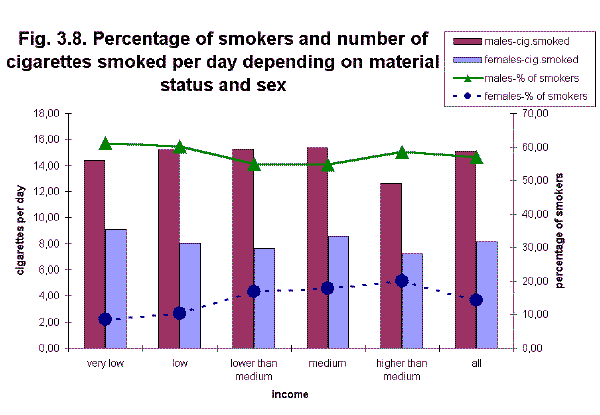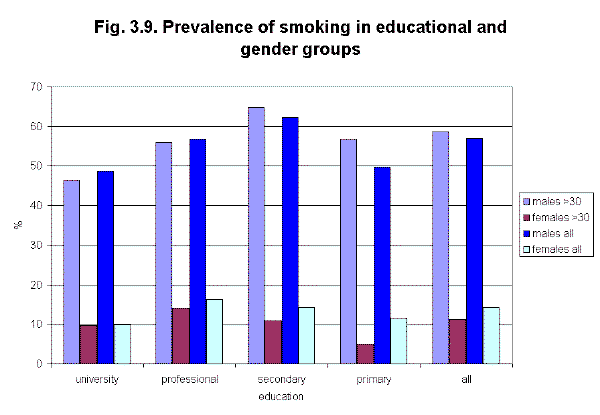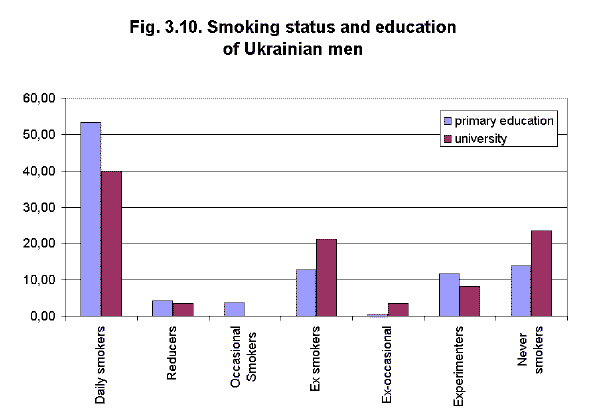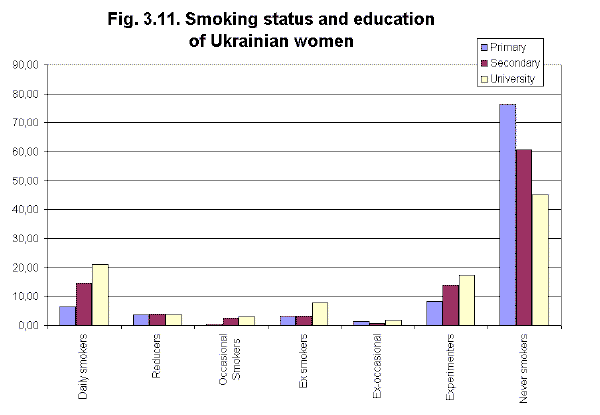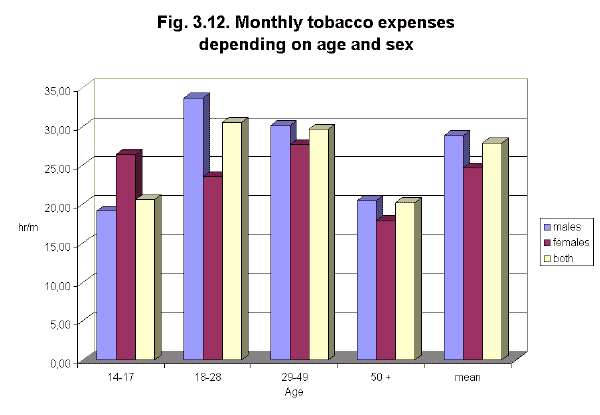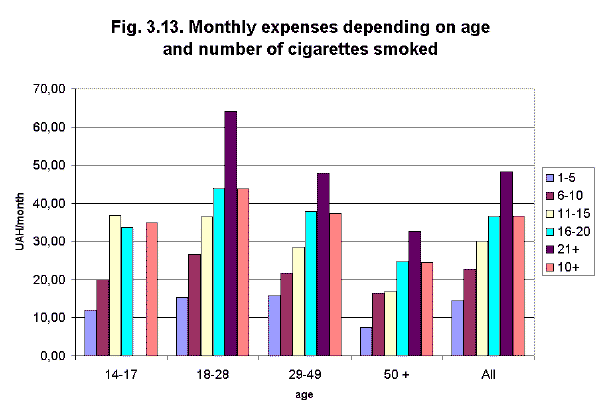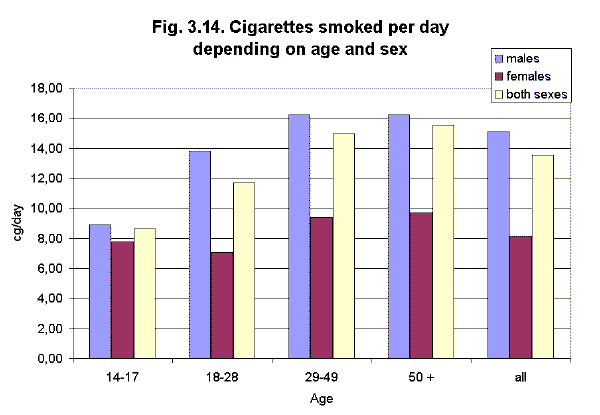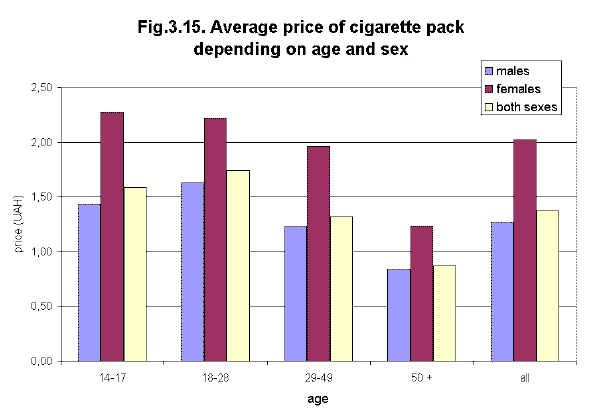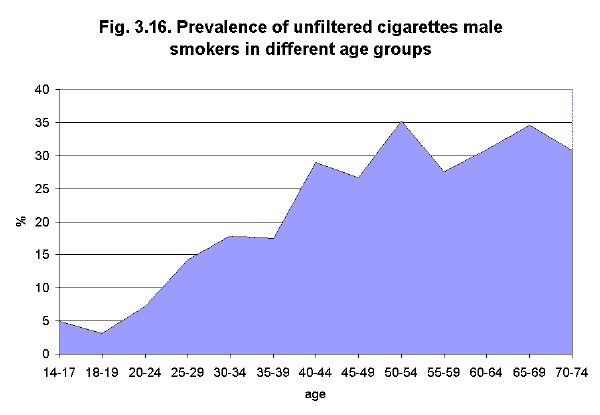3.3. Peculiarities of smoking prevalence and tobacco consumption
The proportion of smokers to nonsmokers among men and women is represented in Table 3.3 and Fig. 3.1.
Table 3.3. The proportion of smokers to nonsmokers among men and women (June 2001 survey)
|
sex |
Males |
females |
|
smokers |
56,9 |
14,2 |
|
nonsmokers |
43,1 |
85,8 |
The percentage of people with different types of smoking status according to the results of the November 2000 survey is represented in Table 3.4 and in two diagrams (see Fig. 3.2, 3.3).
Table 3.4. The distribution of different types of smoking status among males and females (November 2000 survey)
|
|
Males |
Females |
All |
|
Daily smokers |
57,7 |
13,5 |
34,1 |
|
Reducers |
5,1 |
3,9 |
4,5 |
|
Occasional Smokers |
1,6 |
2,1 |
1,8 |
|
Exsmokers |
12,8 |
3,6 |
7,9 |
|
Ex-occasional |
1,0 |
1,0 |
1,0 |
|
Experimenters |
7,2 |
13,0 |
10,3 |
|
Never smokers |
14,5 |
62,7 |
40,2 |
DEFINITIONS (see УGuidelines for controlling and monitoring the tobacco epidemic. Tobacco or health programme. World Health Organization. Ц March 1996Ф)
| Daily smokers Ц people who smoke any tobacco product at least once a day. | |
| Reducers Ц people who used to smoke daily but now do not smoke everyday. | |
| Occasional smokers Ц people who have smoked 100 or more cigarettes and now smoke occasionally (not everyday). | |
| Ex-smokers Ц people who were formerly daily smokers, but currently do not smoke at all. | |
| Ex-occasional smokers are those who were formerly occasional, but never daily smokers and who smoked 100 or more cigarettes in their lifetime. | |
| Experimenters Ц people who have smoked less than 100 cigarettes and now smoke occasionally. | |
| Never smokers Ц those who have either (i) have never smoked at all, or (ii) have never been daily smokers and have smoked less than 100 cigarettes in their lifetime. |
Distribution of different types of smoking status for inhabitants of different size settlements see in Table 3.5. The larger the settlement, the larger the proportion of daily smokers, reducers, experimenters and the smaller the proportion of people who have never smoked and occasional smokers. The proportion of former smokers is the largest in small towns (district centers).
Table 3.5. Distribution of different types of smoking status for inhabitants of different size settlements (November 2000 survey)
|
REGCENTR |
DISTCNTR |
VILLAGE |
Daily smokers |
41,73% |
31,96% |
29,48% |
Reducers |
6,39% |
3,98% |
3,17% |
Occasional Smokers |
1,32% |
1,92% |
2,24% |
Ex smokers |
7,33% |
9,33% |
6,53% |
Ex-occasional |
1,69% |
0,69% |
0,75% |
Experimenters |
12,97% |
9,19% |
9,14% |
Never smokers |
28,57% |
42,94% |
48,69% |
Age
The age distribution of smoking prevalence (Table 3.6 and Fig. 3.4) shows that:
Table 3.6. Percentage of smokers depending on age and sex (June 2001 survey)
|
|
14 - 15 years |
16 - 17 years |
18 - 24 years |
25 - 28 years |
29 - 39 years |
40 - 49 years |
50 - 59 years |
60 - 70 years |
71+ |
|
males |
23,1 |
44 |
58,0 |
64,8 |
65,5 |
60,4 |
53,8 |
41,0 |
57,1 |
|
females |
|
16,0 |
27,6 |
23,2 |
17,5 |
8,4 |
7,1 |
0,7 |
|
1. There are age waves of smoking prevalence. Male smoking prevalence is the largest in the 29-39-year-old group and then is lower in every next age group from 40 to 70 years old and increases after 70, but this last group is rather small. Female smoking prevalence is the highest in the 18-24-year-old group and it decreases in all the groups older than that.
2. Male smoking prevalence is higher than female smoking prevalence in all age groups, but this difference grows from two-fold in the 20-year-old group to almost 8-fold in the 50-59-year-old group.
Since highest prevalence of male and female smoking is seen in different age groups, this reflects that the male and female tobacco epidemics in Ukraine are at different stages.
The curve describing male smoking age distribution consists of ascending and descending parts. The ascending part of the curve represents the level and age of smoking initiation. The descending part of the curve after the maximum level of smoking at 26-39 years old could represent a loss of smokers due to death or quitting. According to the existing epidemiological models, there is no significant smoking-related mortality before the age of 35, and one quarter of smokers die due to smoking-related diseases before 70. In view of that, we created models describing the percentages of smokers in age groups starting from 35 (See Table 3.7 and Fig. 3.5). All three (linear, inverse and exponential) models accurately describe the observed percentages of male smokers in 35-55 age groups.
Table 3.7. The calculated and observed percentages of male smokers in the 35-65 year-old age groups (June 2001 survey)
|
35 years |
45 years |
55 years |
65 years |
Y=b0+b1*x=125-x*5/7 |
65,5 |
60,8 |
56,1 |
51,5 |
Y=b0+b1/x=50+1750/x |
65,5 |
58,2 |
53,6 |
50,4 |
Y=b0*b1^((x-35)/10)=100*0,92^((x-35)/10) |
65,5 |
60,3 |
55,6 |
51,2 |
Observed |
65,5 |
60,4 |
53,7 |
41,0 |

The lower observed percentage in the 60-70-year-old age group can be derived from either (i) lower levels of smoking initiation for those who were teenagers in 1950s or (ii) their higher quitting rates.
To check which of these hypotheses is right, we used the results of the November 2000 survey where smoking status was thoroughly explored. Males questioned in that survey had the following distribution by smoking status and age (Table 3.8).
Table 3.8. Distribution of males with different types of smoking status in different age groups (November 2000 survey)
|
15 years |
16-17 years |
18-24 years |
25-28 years |
29-39 years |
40-49 years |
50-59 years |
60-69 years |
70-79 years |
Totals |
Regular smokers |
14,3 |
28,0 |
58,4 |
61,8 |
66,3 |
69,9 |
61,4 |
48,4 |
30,9 |
57,7 |
Reducers |
0,0 |
0,0 |
5,9 |
2,9 |
8,0 |
5,1 |
5,2 |
3,3 |
5,5 |
5,1 |
Occasional smokers |
14,3 |
4,0 |
3,0 |
1,5 |
0,6 |
0,7 |
1,3 |
0,0 |
3,6 |
1,6 |
Quitters |
7,1 |
4,0 |
5,0 |
16,2 |
5,5 |
8,8 |
15,0 |
29,5 |
30,9 |
13,7 |
Experimenters |
35,7 |
36,0 |
14,9 |
4,4 |
3,1 |
4,4 |
3,9 |
6,6 |
5,5 |
7,2 |
Nonsmokers |
28,6 |
28,0 |
12,9 |
13,2 |
16,6 |
11,0 |
13,1 |
12,3 |
23,6 |
14,7 |
It seems that both hypotheses have enough evidence.
The first hypothesis seems probable, since the group of people who had never smoked in the 70+ year-old age group is twice as large as previous age groups.
The second hypothesis can also be true, since the proportion of quitters increased from 5.5% in the 29-39-year-old age group to 15% in the 50-59 year-old age group and 29-30% in the 60+ year-old age groups.
Maximal prevalence observed in the 35 year-old age group may represent the state of a developed smoking epidemic among males, which currently is not increasing.
The curve describing female smoking age distribution has its descending part starting from the 18-24 -year-old age group. The descending part here seems to represent not the levels of smoking-related mortality, but the levels of smoking initiation in previous decades. ItТs obvious that the smoking epidemic among Ukrainian females is still growing.
A comparison of the average age of daily smokers and former daily smokers (see Fig. 3.6, November 2000 survey) shows that the average age of former smokers is 11-12 years older than that of current daily smokers both for men and women. Therefore, in order to stop smoking in Ukraine, it takes 11-12 years of smoking in average.
The average age of women was 10 years younger than that of men, both for smokers and former smokers.
The age of smoking initiation and the way it influences the present smoking status can be seen in Fig. 3.7. The largest proportion of daily smokers are those who start smoking between the ages of 10 and 14. The later a person starts to smoke, the lower the probability that they will become a daily smoker, and the higher the probability that they will quit smoking by a certain age.
Income
The level of tobacco expenses together with smoking prevalence and intensity for different income groups is presented in Table 3.9 and Fig. 3.8. The overall trend is that the higher the subjective estimation of material status, the higher the percentage of smokers, but the lower the quantity of cigarettes smoked per day.
Table 3.9. Percentage of smokers, intensity of smoking and tobacco expenses depending on sex and subjective assessment of material status (June 2001 survey)
|
Verylow |
Low |
Lower than medium |
Medium |
Higher than medium |
All |
|
|
males-cig. smoked |
14,39 |
15,20 |
15,24 |
15,34 |
12,63 |
15,08 |
|
Females-cig. smoked |
9,12 |
8,02 |
7,61 |
8,61 |
7,20 |
8,15 |
|
males-% of smokers |
61,19 |
60,14 |
54,97 |
54,74 |
58,54 |
56,87 |
|
Females-% of smokers |
8,54 |
10,28 |
16,75 |
17,81 |
20,00 |
14,23 |
|
males-expenses |
19,72 |
22,64 |
27,45 |
36,86 |
38,13 |
28,85 |
|
Females-expenses |
18,00 |
22,56 |
20,31 |
31,01 |
26,00 |
24,69 |
A comparison of smoking prevalence in different income groups shows there are two peaks for males Ц in very low and comparatively high-income groups Ц and one peak in the high-income group for females. High smoking prevalence in the male high-income group could be the result of miss-representation of this group, as people with a high income usually hide it and say that they have medium income.
Education
A comparison of smoking prevalence in different educational groups shows the lowest smoking prevalence in the group with a university education, and the highest in secondary and professional education groups (see Table 3.10 and Fig. 3.9). As young people could significantly change results in primary and secondary education groups, the prevalence of smoking in groups of respondents over 30 is shown for comparison.
Table 3.10. Percentage of smokers depending on education and sex (June 2001 survey)
|
|
University |
Professional |
Secondary |
Primary |
All |
|
Males >30 |
46,45 |
55,93 |
64,82 |
56,82 |
58,61 |
|
Females >30 |
9,71 |
14,02 |
10,92 |
5,00 |
11,23 |
|
Males all |
48,81 |
56,69 |
62,24 |
49,72 |
56,89 |
|
Females all |
9,91 |
16,24 |
14,29 |
11,61 |
14,19 |
In the November 2000 survey, we examined the dependence of smoking status upon education. The results for men are represented in Table 3.11 and Fig. 3.10 and for women in Table 3.12 and Fig. 3.11.
Table 3.11. The distribution of different types of smoking status for males with primary and university education (November 2000 survey)
|
|
Education |
|
|
Smoking status |
Primary education |
University education |
|
Daily smokers |
53,19 |
40,00 |
|
Reducers |
4,26 |
3,53 |
|
Occasional Smokers |
3,72 |
|
|
Ex smokers |
12,77 |
21,18 |
|
Ex-occasional |
0,53 |
3,53 |
|
Experimenters |
11,70 |
8,24 |
|
Never smokers |
13,83 |
23,53† |
Table 3.12. The distribution of different types of smoking status for females with primary, secondary and university education (November 2000 survey)
|
|
Education |
||
|
Smoking status |
Primary |
Secondary |
University |
|
Daily smokers |
6,45 |
14,76 |
21,15 |
|
Reducers |
3,69 |
3,92 |
3,85 |
|
Occasional Smokers |
0,46 |
2,51 |
2,88 |
|
Ex smokers |
3,23 |
3,14 |
7,69 |
|
Ex-occasional |
1,38 |
0,78 |
1,92 |
|
Experimenters |
8,29 |
13,97 |
17,31 |
|
Never smokers |
76,50 |
60,75 |
45,19 |
For men, a university education corresponds to a smaller percentage of daily smokers and experimenters, and a higher percentage of former daily and occasional smokers and people who have never smoked (in contrast to primary education).
For women, the results differ from those of men. The higher the education, the higher the percentage of daily smokers and experimenters and the lower the percentage of those who have never smoked. This also shows the growing character of tobacco epidemic among women in Ukraine.
Tobacco expenditures
The average monthly tobacco expenses are represented in Table 3.13 and Fig. 3.12. Males have the highest expenses in 18-28-year-old age group, but afterwards they decrease. Teenagers of 14-17 years old have the lowest expenses. Females show peak expenses in 14-17 and 29-49 age groups.
Table 3.13. Average monthly tobacco expenses depending on age and sex (June 2001 survey)
|
14-17 |
18-28 |
29-49 |
50 + |
mean |
|
|
Males |
19,16 |
33,69 |
30,09 |
20,49 |
28,80 |
|
Females |
26,44 |
23,57 |
27,68 |
17,94 |
24,69 |
|
Both |
20,59 |
30,53 |
29,64 |
20,21 |
27,90 |
Then it was examined how the number of cigarettes smoked and the price of cigarettes influence tobacco expenditures in different age and sex groups.
Monthly expenses depending on age and the number of cigarettes smoked are represented in Table 3.14 and Fig. 3.13.
Table 3.14. Monthly expenses (UAH) depending on age and the number of cigarettes smoked (June 2001 survey)
|
Age |
14-17 |
18-28 |
29-49 |
50+ |
All |
|
Number of cigarettes smoked per day |
|
|
|
|
|
|
1-5 |
12,06 |
15,28 |
15,76 |
7,54 |
14,50 |
|
6-10 |
20,00 |
26,59 |
21,77 |
16,55 |
22,69 |
|
11-15 |
36,75 |
36,50 |
28,46 |
17,06 |
30,03 |
|
16-20 |
33,67 |
44,01 |
37,81 |
24,91 |
36,58 |
|
21+ |
64,07 |
47,92 |
32,62 |
48,35 |
|
|
10+ |
34,90 |
43,73 |
37,32 |
24,52 |
36,58 |
Expenses grow with the increase of the number of cigarettes smoked in age groups older than 17 years old. In the 14-17-year-old group, those who smoke 16-20 cigarettes per day spend less money than those who smoke 10-15 cigarettes per day. There were no respondents who smoke 20+ and cigarettes per day.
In groups with the same intensity of smoking highest expenses are in 18-28 years old group, afterwards expenses decrease, as smokers switch to cheaper cigarettes.
These trends of expenses are influenced by the increase of cigarettes smoked per day (Table 3.15, Fig. 3.14) and the decrease of their average price (Table 3.16, Fig. 3.15).
Table 3.15. Average number of cigarettes smoked per day depending on age and sex (June 2001 survey)
|
Age |
14-17 |
18-28 |
29-49 |
50 + |
All |
|
Sex |
|||||
|
Males |
8,92 |
13,79 |
16,23 |
16,22 |
15,07 |
|
Females |
7,75 |
7,07 |
9,40 |
9,71 |
8,15 |
|
Both sexes |
8,64 |
11,68 |
14,96 |
15,51 |
13,54 |
Table 3.16. Average price of cigarette pack depending on age and sex (June 2001 survey)
|
Age |
14-17 |
18-28 |
29-49 |
50 + |
All |
|
Sex |
|||||
|
Males |
1,43 |
1,63 |
1,24 |
0,84 |
1,27 |
|
Females |
2,27 |
2,22 |
1,96 |
1,23 |
2,02 |
|
Both sexes |
1,59 |
1,74 |
1,32 |
0,87 |
1,37 |
The percentage of males in different age groups who smoke non-filter cigarettes is represented in Fig. 3.16. The growing proportion of older people smoking non-filter cigarettes also adds to the trend that older smokers smoke more cigarettes for a smaller price.
Total tobacco consumption in Ukraine
For consumption estimation the following data was used:
- the age structure of the population;
- smoking prevalence in different age groups;
- the average quantity of cigarettes smoked per day.
The calculations of cigarettes consumed in 2001 are presented in Table 3.17. The total amount of cigarettes smoked in Ukraine in the year 2001 is estimated at 67 billion pieces, 88% of which is smoked by men and 12% by women. Teenagers from 14 to 17 years old smoke 3.3%.
The total expenses of Ukrainian smokers are estimated at about 4.1 billion UAH (see Table 3.18). The proportion of expenses born by young people of 14-17 years old is estimated to be 4.76% of the total amount.
The number of non-filter cigarettes costing less than 1 UAH per pack is estimated at 25.8 billion pieces or 38.3% of the total cigarette market (see Table 3.19).
Expected reactions to a cigarette price increase
The following predictors of respondentsТ reactions to cigarette price increase were found:
People are more likely to maintain their level of smoking if they:
| - are single young adults; | |
| - consider their material status satisfactory; | |
| - smoke less than 5 or more than 15 cigarettes; | |
| - smoke the cheapest or the most expensive cigarettes; | |
| - spend more on cigarettes than 30 UAH per month. |
People are more likely to shift to cheaper cigarettes if they:
| - are males over 30 years old smoking 10-20 cigarettes per day; | |
| - are females bearing children and smoking 5-15 cigarettes per day; | |
| - are smokers with a family; | |
| - consider their material status to be rather low; | |
| - smoke cheap cigarettes. |
People are more likely to reduce smoking if they:
| - are teenagers; | |
| - are smokers with a family; | |
| - are married women; | |
| - have a low income; | |
| - spend less on cigarettes than 30 UAH per month; | |
| - smoke expensive cigarettes; | |
| - smoke 5-15 cigarettes per day; | |
| - live in big cities. |
People are more likely to quit smoking if they:
| - are older than 30; | |
| - are married men and women; | |
| - smoke less than 10 cigarettes per day; | |
| - smoke cigarettes that cost 1-2 UAH per pack; | |
| - spend less money on cigarettes than others; | |
| - have an extremely low income. |
The influence of preferred cigarette price per pack to reactions of smokers to cigarette price increase is represented in Table 3.20 and Fig. 3.17
Table 3.20. Reactions to price increase depending on the price of preferred cigarettes per pack
|
Sex |
Price |
Keep |
Cheaper |
Reduce |
Quit |
All |
||||
|
N |
% |
N |
% |
N |
% |
N |
% |
N |
||
|
Males |
<1,0 |
82 |
34,5 |
45 |
18,9 |
71 |
29,8 |
40 |
16,8 |
238 |
|
1,0-2,0 |
124 |
34,3 |
76 |
21,0 |
98 |
27,1 |
64 |
17,7 |
362 |
|
|
2,1-3,0 |
21 |
33,3 |
10 |
15,9 |
20 |
31,7 |
12 |
19,0 |
63 |
|
|
3,1-4,0 |
8 |
61,5 |
2 |
15,4 |
2 |
15,4 |
1 |
7,7 |
13 |
|
|
>4,0 |
3 |
42,9 |
1 |
14,3 |
1 |
14,3 |
2 |
28,6 |
7 |
|
|
238 |
34,8 |
134 |
19,6 |
192 |
28,1 |
119 |
17,4 |
683 |
||
|
Females |
<1,0 |
4 |
28,6 |
4 |
28,6 |
3 |
21,4 |
3 |
21,4 |
14 |
|
1,0-2,0 |
31 |
26,7 |
17 |
14,7 |
37 |
31,9 |
31 |
26,7 |
116 |
|
|
2,1-3,0 |
14 |
32,6 |
6 |
14,0 |
18 |
41,9 |
5 |
11,6 |
43 |
|
|
3,1-4,0 |
2 |
18,2 |
0,0 |
8 |
72,7 |
1 |
9,1 |
11 |
||
|
>4,0 |
4 |
40,0 |
3 |
30,0 |
0,0 |
3 |
30,0 |
10 |
||
|
55 |
28,4 |
30 |
15,5 |
66 |
34,0 |
43 |
22,2 |
194 |
||
|
Both |
<1,0 |
86 |
34,1 |
49 |
19,4 |
74 |
29,4 |
43 |
17,1 |
252 |
|
1,0-2,0 |
155 |
32,4 |
93 |
19,5 |
135 |
28,2 |
95 |
19,9 |
478 |
|
|
2,1-3,0 |
35 |
33,0 |
16 |
15,1 |
38 |
35,8 |
17 |
16,0 |
106 |
|
|
3,1-4,0 |
10 |
41,7 |
2 |
8,3 |
10 |
41,7 |
2 |
8,3 |
24 |
|
|
>4,0 |
7 |
41,2 |
4 |
23,5 |
1 |
5,9 |
5 |
29,4 |
17 |
|
|
293 |
33,4 |
164 |
18,7 |
258 |
29,4 |
162 |
18,5 |
877† |
||

It is obvious that all of the price groups have similar reactions to price increase, and the highest percentage of those who tend to reduce or quit smoking is among those who smoke cigarettes with prices from 2 to 3 UAH.
For all the mentioned factors, we calculated quotients enabling us to predict whether this factor increases or decreases the probability of a certain reaction to a price increase. These quotients were used to estimate the result of combined factors influencing and predicting the behavior of typical groups of smokers.
A group of low income smokers, aged over 50, smoking cheap cigarettes, and living in cities and towns was considered (see Table 3.21 and Fig. 3.18). The result was that 70% of them expect to reduce or quit smoking (48% in general smokers population).
Table 3.21. The calculation of different reactions possible for a combination of factors (June 2001 survey)
|
Reaction to price increase |
Keep |
Cheaper |
Reduce |
Quit |
|
Surveyed population (%) |
33,37 |
18,68 |
29,38 |
18,56 |
|
Age over 50 |
0,88 |
1,03 |
1,07 |
1,07 |
|
Low income |
0,74 |
0,97 |
1,10 |
1,33 |
|
Poor |
0,93 |
1,01 |
1,02 |
1,08 |
|
Tobacco expenses < 30 UAH per month |
0,96 |
0,92 |
1,09 |
1,03 |
|
Price of pack < 2 UAH |
0,99 |
1,04 |
0,97 |
1,02 |
|
Cities and towns |
0,97 |
0,91 |
1,06 |
1,06 |
|
Combination of factors |
0,56 |
0,87 |
1,35 |
1,69 |
|
Resulting percentage |
18,64 |
16,32 |
39,81 |
31,37 |
|
Difference (%) |
-14,73 |
-2,36 |
10,43 |
12,81 |

Groups of teenagers from families with different levels of income were also considered (see Fig. 3.19). All teenagers expect to reduce smoking with a higher probability than adults. Teenagers from poor families tend to reduce or quit smoking in comparison to teenagers from rich families.

In our first survey (November 2000) we examined the quitting behavior of smoking respondents. The percentage of male daily smokers willing to quit and those who have already made efforts to quit is represented in Fig. 3.20. The percentages of those who have applied for professional help and used medicine can be seen in Fig. 3.21.

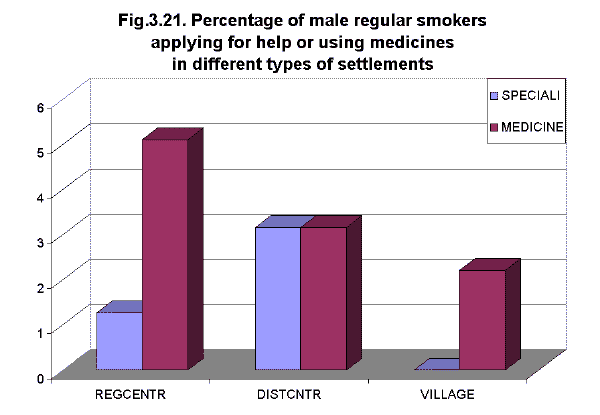
As seen on the charts, inhabitants of small towns (district centers) are most willing to quit smoking and have made more efforts to apply for professional help than the inhabitants of larger cities and villages. This coincides with the highest percentage of ex-smokers in district centers as compared to larger cities and villages.
The attitude to a Pension insurance fund tax on cigarettes depending on the respondentТs sex, place of living, and smoking status was also studied (see Fig. 3.22-3.24). People who have never smoked and former smokers are the most positive about the tax, and almost half of them presume it should be increased. All types of current smokers respond that the tax should be either left as it is or decreased.
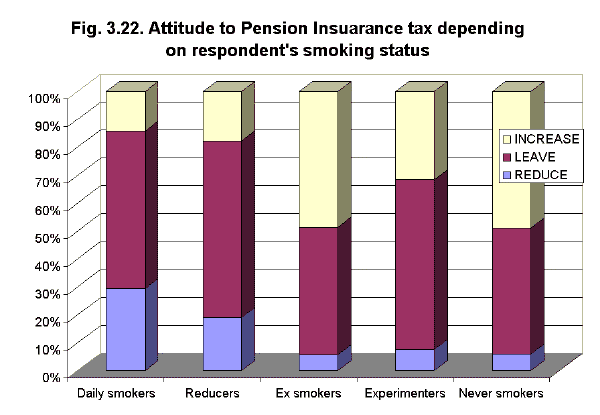
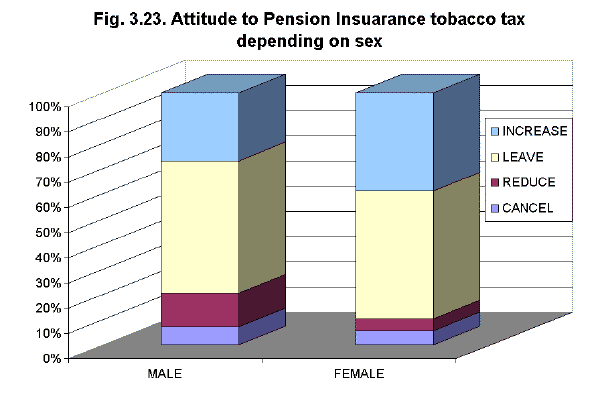

Women are more positive about tobacco taxes than men. Inhabitants of villages and smaller towns support tobacco taxes more than inhabitants of larger cities.
Groups of smokers and types of brands
Since all of the smokers surveyed in the June 2001 survey were asked about their preferred cigarette brands, the list of brands mentioned by respondents contains more than one hundred items. Therefore, dimension reduction was undertaken to examine which sets of brands correspond to certain types of tobacco consumption. This was done by means of factor analysis. Factors were determined as a result of dimension reduction of the brands preferred. 8 varimax normalized rotation factors were constructed and interpreted.
For every smoker respondent, values of all 8 factors were calculated. Afterwards, groups of smokers with high factor values were formed. A person entering a certain group in case the normalized value of the corresponding factor was 1.00 or higher. If none of the eight factors was 1.00 or higher, then a person entered the 0-group. If more than one factor had high levels, then a person entered a group corresponding to the factor with the highest value.
The characteristics of smoking patterns and socio-demographic information were examined for every group. In addition, the answers about personal plans in case of cigarette price increase were compared for eight groups.
FILTERED LICENSED - Factor 1
The high values of this factor unite the 22% of smokers who prefer filtered licensed middle price cigarettes (Bond, L&M, Monte Carlo, West). These are mostly inhabitants of larger cities, middle to high income, mostly single or divorced, with almost twice as manywomen than in the general population of smokers and with a higher proportion of people younger than 30 years old. They smoke up to 10 cigarettes per day, and in case of a price increase they expect to keep the same level of smoking or reduce it, but are not going to quit or to smoke cheaper cigarettes.
CHEAP - Factor 6
The high values of this factor unite the 11% smokers who prefer cheap cigarettes (Prima, Vatra, Express, Kozak, Otaman).
Village inhabitants, people with a low income, and married males over 50 prevail. The proportion of males is the highest in this group (96%). Their education is mostly primary or secondary.
In case of a price increase, they expect to shift to cheaper cigarettes.
VERY EXPENSIVE - Factor 4
The high values of this factor unite the 10% of smokers who prefer very expensive cigarettes (Camel, Davidoff, Parliament, R1, Lucky Strike, Marlboro).
They are mostly 18-28 years old with a university education or have not yet graduated, inhabitants of cities and towns, and consider their income to be higher than that of others.
Most of them smoke less than 10 cigarettes per day.
In case of a price increase, they expect to keep smoking as before, but they also consider the possibility of quitting smoking.
NOSTALGIC - Factor 8
The high values of this factor unite the 5% of smokers who prefer cigarettes with nostalgic images (Kosmos, Sojus-Appolo, Rodopy, Java, Opal, BT).
These are the inhabitants of villages and towns, and the group consists almost exclusively of males.
They smoke more cigarettes per day than average in smokersТ population.
In case a of price increase, they expect to shift to cheaper cigarettes.
MOLDOVA - Factor 2
The high values of this factor unite the 3% of smokers who prefer cigarettes produced in Moldova (Turne, Fluerash, Doine).
These are village inhabitants of the regions neighboring Moldova; mostly married males over 30.
There are more people in this group with a secondary or professional school education and a very low income.
They smoke more than 15 cigarettes a day, and in case of a price increase they plan to shift to cheaper cigarettes rather than maintain their level of smoking.
EXPENSIVE IMPORTED - Factor 3
The high values of this factor unite the 2% of smokers who prefer expensive cigarettes imported from western countries (Lucky Strike, Winston, Boss). The proportion of big cities inhabitants is the largest in this group, and there are more people in this group who assess their financial status as satisfactory. The frequency of college or university education is higher in this group. There are more people in this group who are single or divorced and more women than in the general population of smokers (35%), though men are in the majority. The age of people in this group is between 18 and 49.
There are two subgroups that smoke less than 5 and 16-20 cigarettes per day. In case of a price increase, they expect to keep the same level of smoking or reduce it, which is probably typical for two subgroups with a different intensity of smoking.
This group is very similar to that chosen by factor 1; the difference is just the price and the place of production of the cigarettes they smoke.
LIGHT - Factor 7
The high values of this factor unite the 2% smokers who prefer light cigarettes (Prima light, Bond light).
They smoke less than 10 cigarettes per day, have a secondary or college education, and a satisfactory level of income. The percentage of females is 43% compared to 22% in surveyed smokers population. The majority of them are less than 30 years old and are not married.
In case of a price increase, they expect to reduce smoking.
SPECIAL - Factor 5
The high values of this factor unite the 1% of smokers who prefer special cigarettes, possibly with a masculine image (President, Novost, LD, Prima).
There are more small towns inhabitants in this group than in the others, with a low income, and a primary, secondary or professional education (no universities or colleges), single, and under 50 years old.
In case of a price increase they expect to decrease the quantity of cigarettes they smoke, switch to cheaper cigarettes, or quit smoking.
The analysis of cigarette brands smoked in Ukraine revealed several groups characterized by different types of tobacco consumption. From the point of view of a behavioral prognosis in case of cigarette price increase, they can be united into larger groups.
Group 1
This consists of groups formed by factors 1, 4, 3, 7, and includes 22%+10%+2%+2%=36% of smokers. They are characterized by comparative well-being, a higher educational level, living in larger cities, a larger proportion of women, consumption of more expensive cigarettes, less intensive smoking and probably a lower level of tobacco dependence, and in case of a price increase they tend to decrease the quantity of cigarettes smoked.
Group 2
This consists of groups formed by factors 2, 5, 6, 8 and includes 11%+5%+3%+1%=20% of smokers. They are characterized by a low level of income and education, living in villages and small towns, a larger percentage of men, a higher intensity of smoking and probably a higher tobacco dependence. They consume cheaper cigarettes, mostly not filtered. In case of a price increase, they tend to shift to even cheaper cigarettes.
The rest of the 44.9% of smokers entered the 0-group (where none of the factors had high values). The characteristics of this group are rather similar to the characteristics of all of the surveyed smokers population. It consists of 84% males and 16% females, and 70% of them are married.
3.4. Economic analysis of tobacco demand and price and income elasticity of cigarettes
| Who we are? |
|
|
|
|
|
|
|
|
|
|
|
|
|
|






